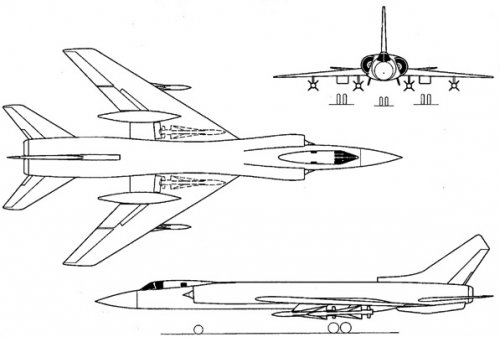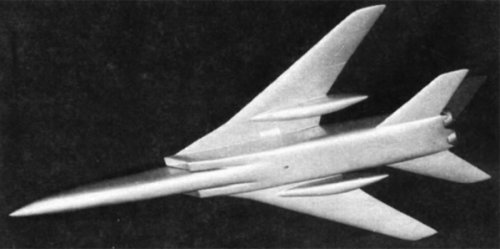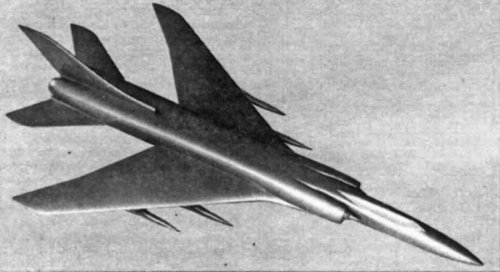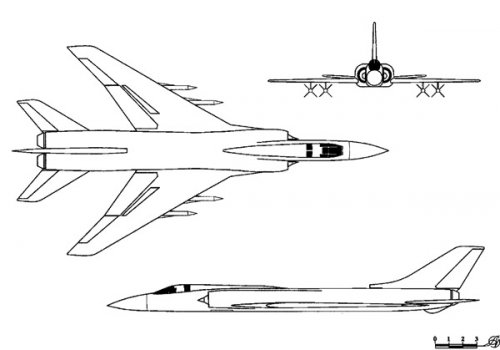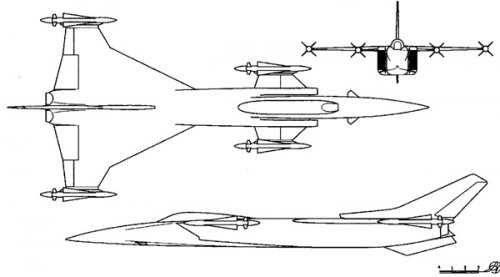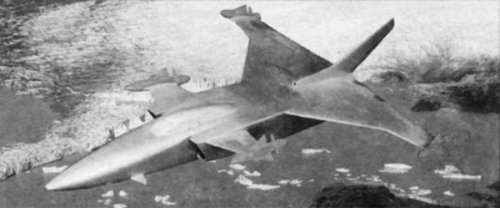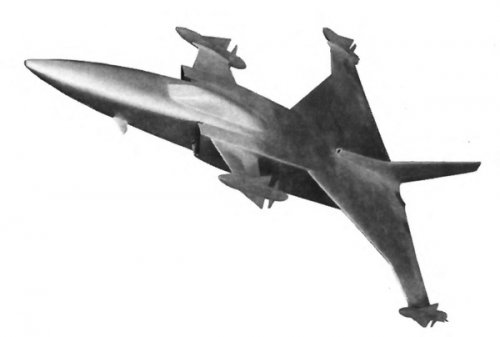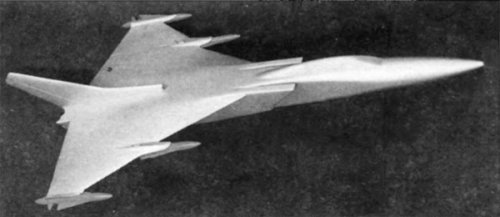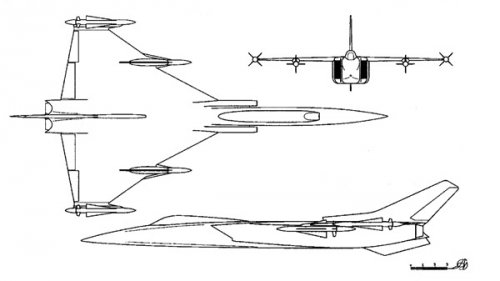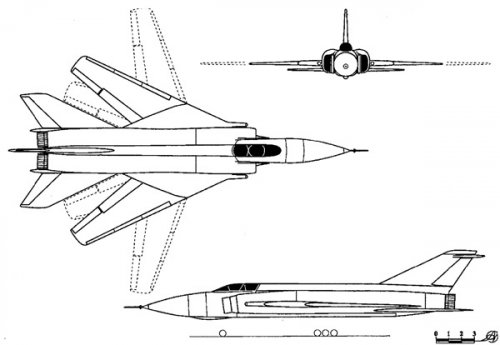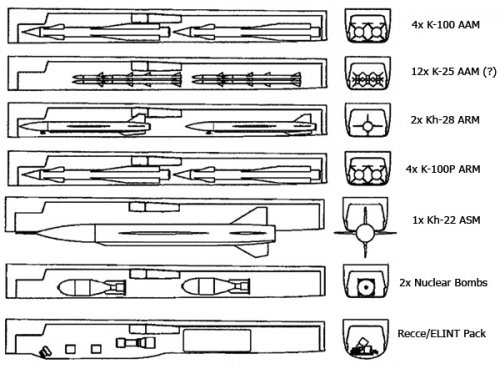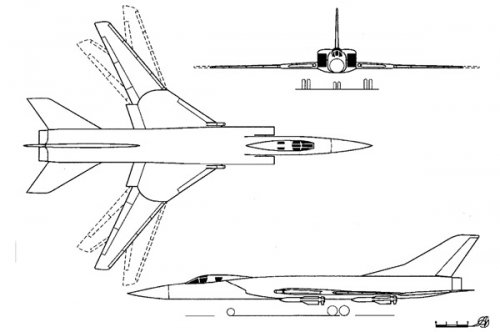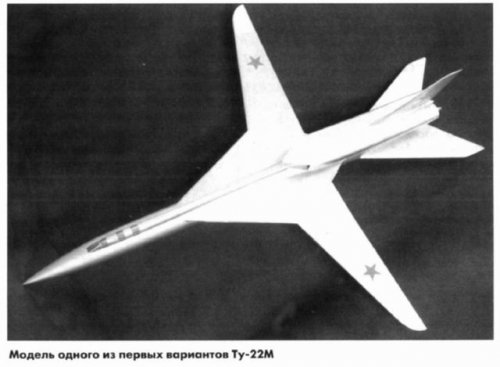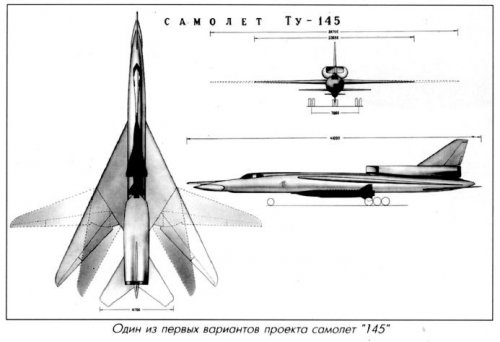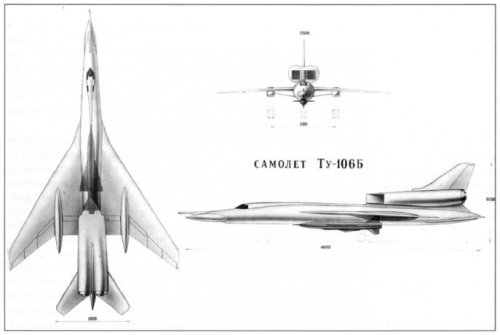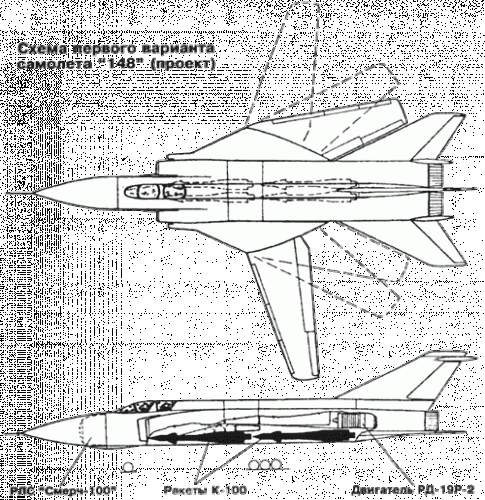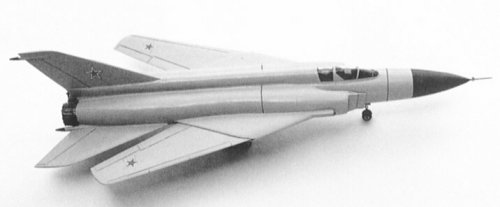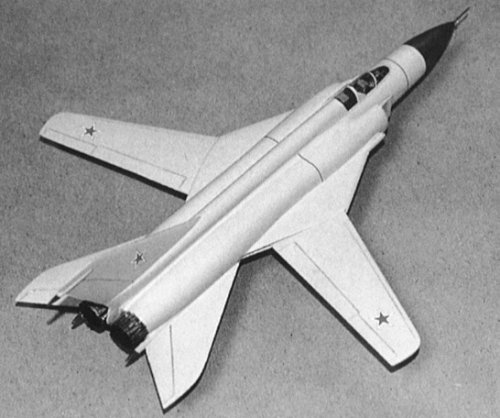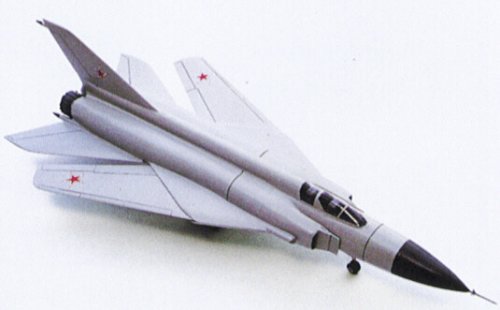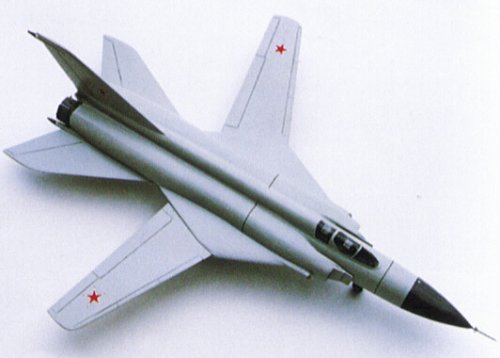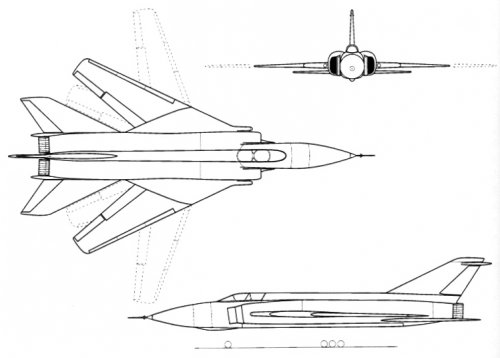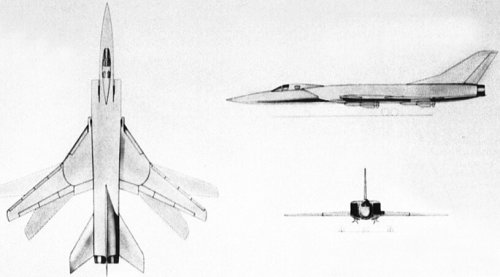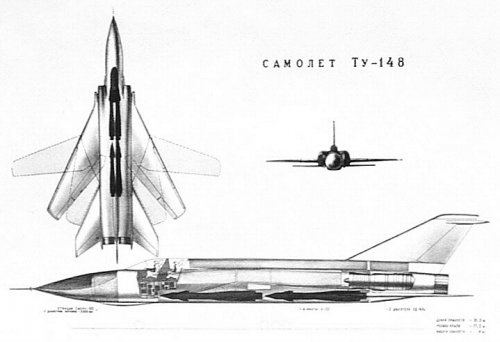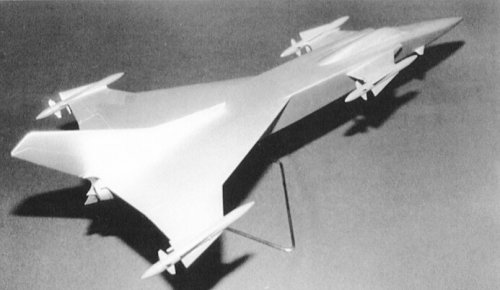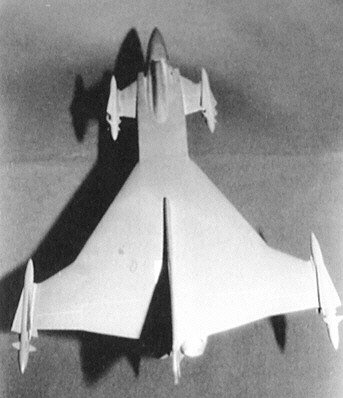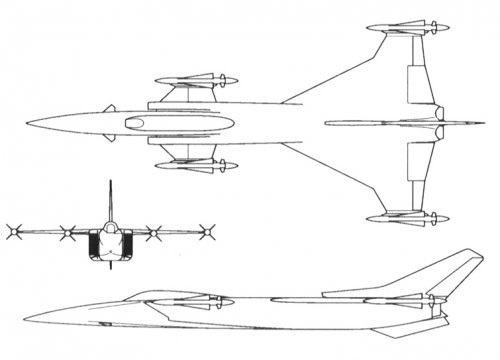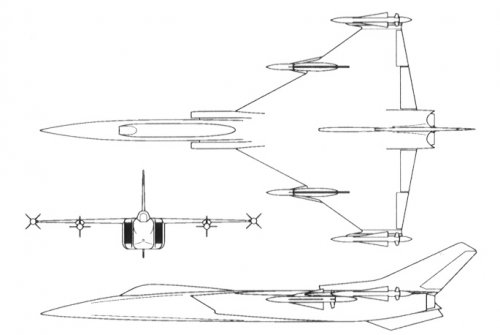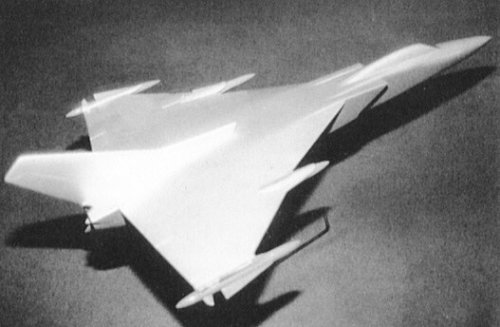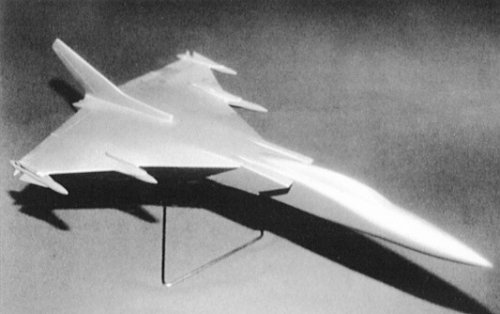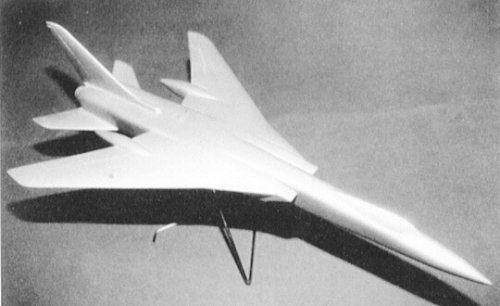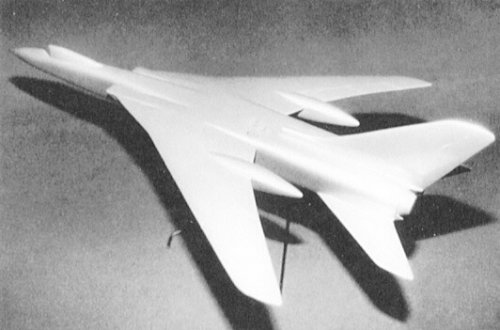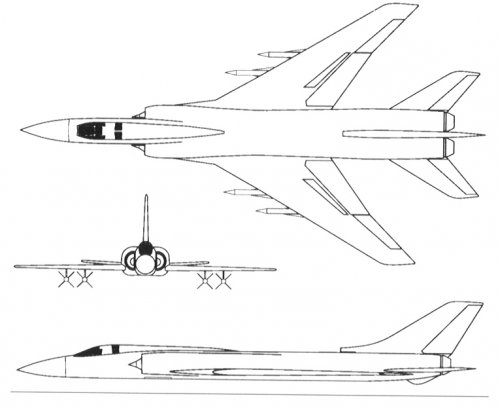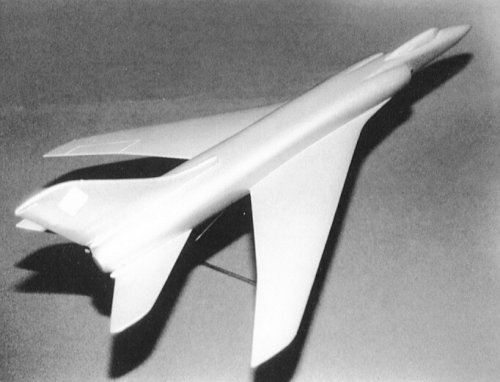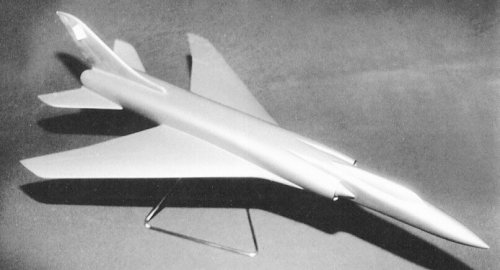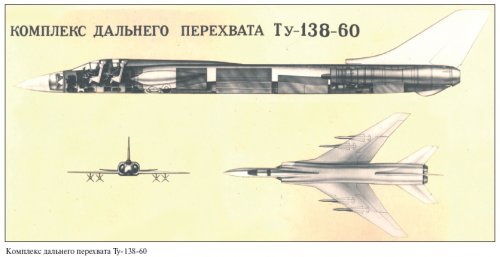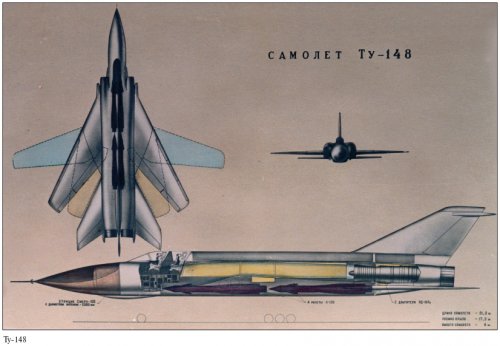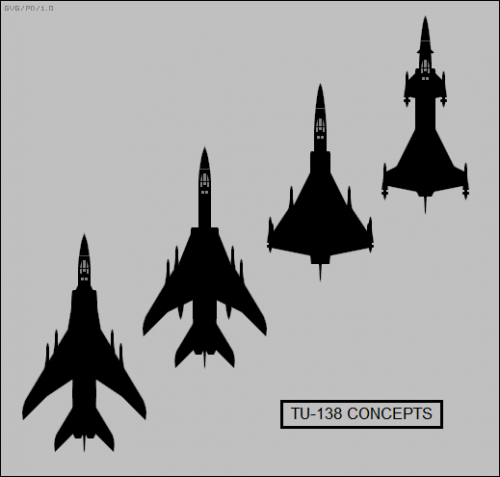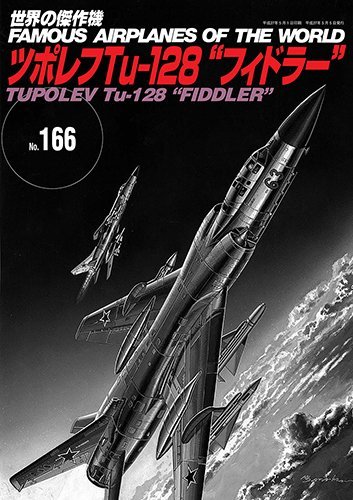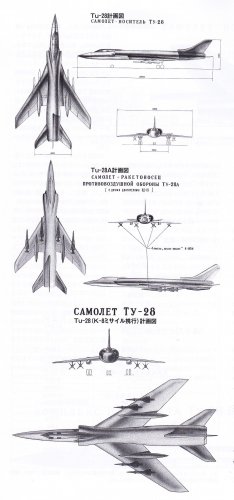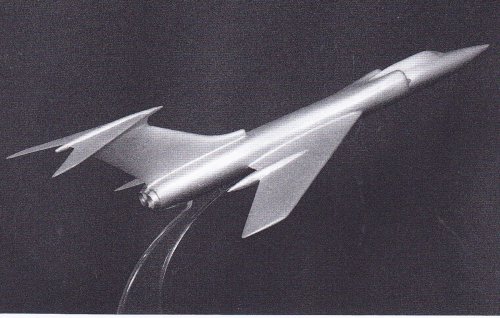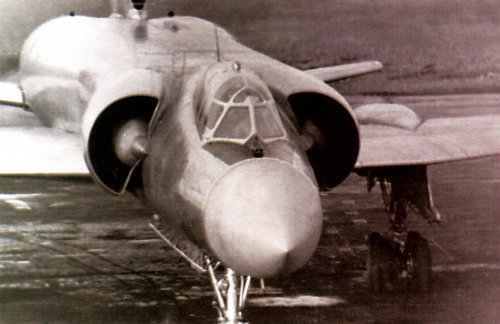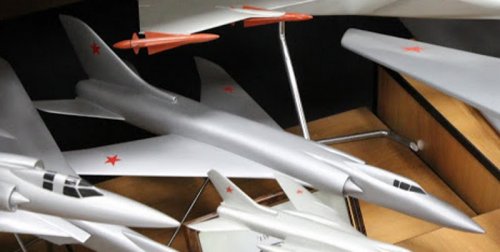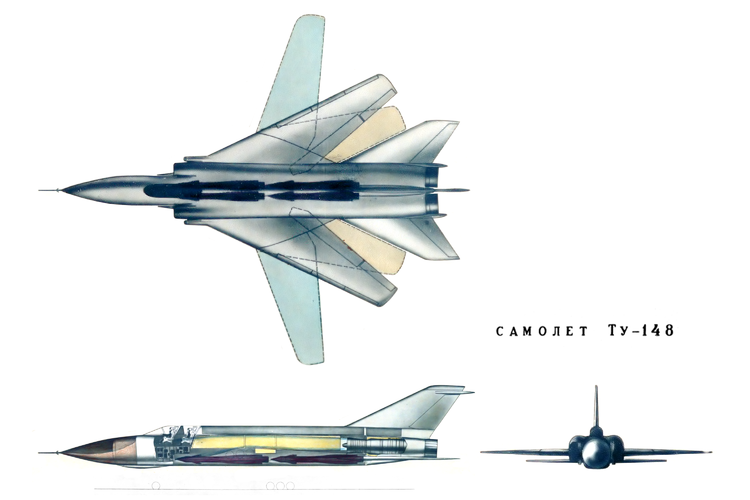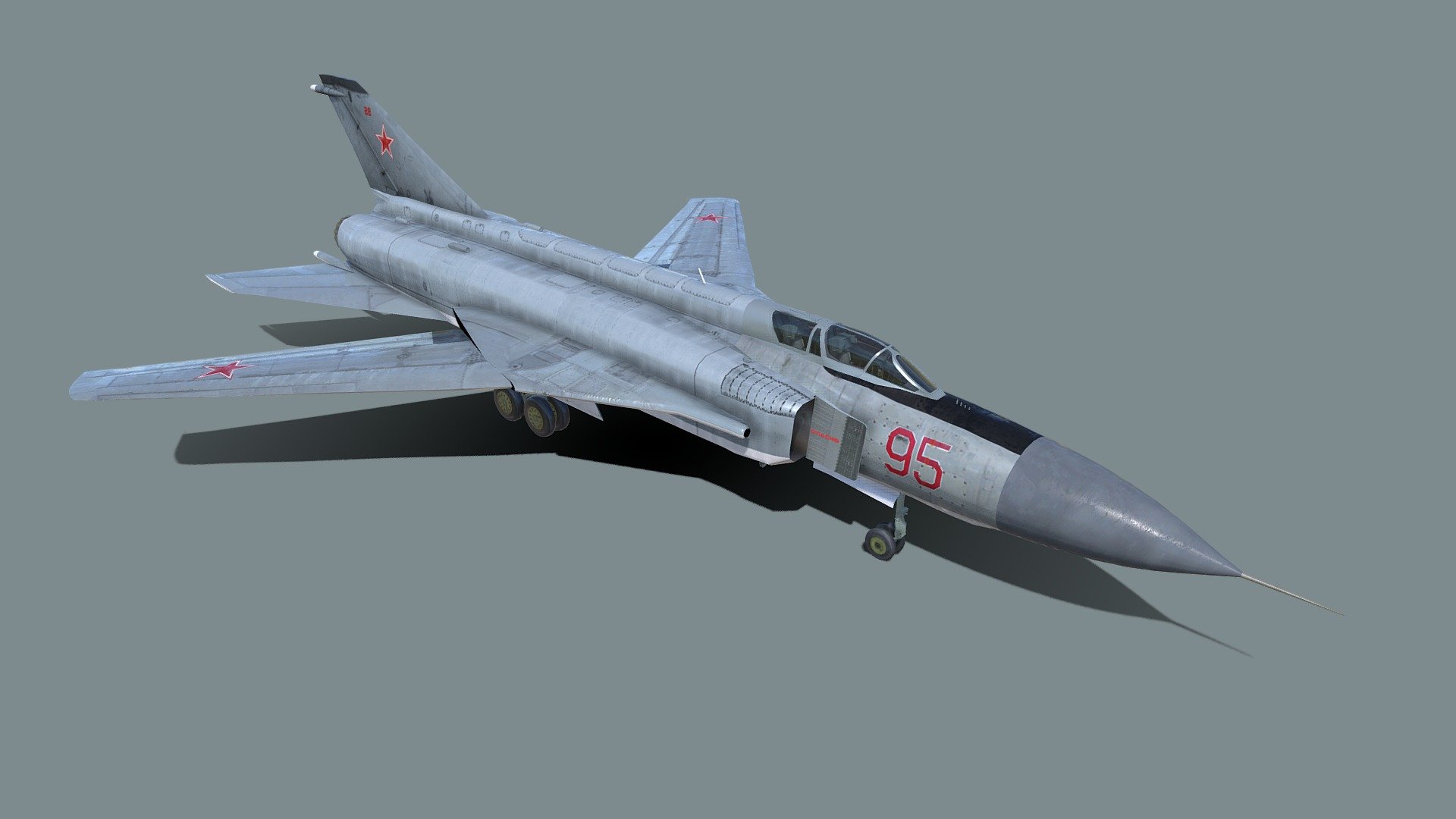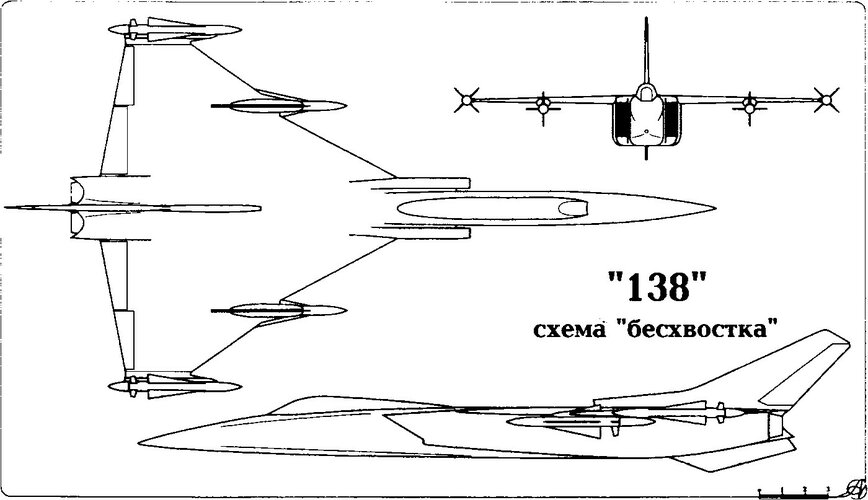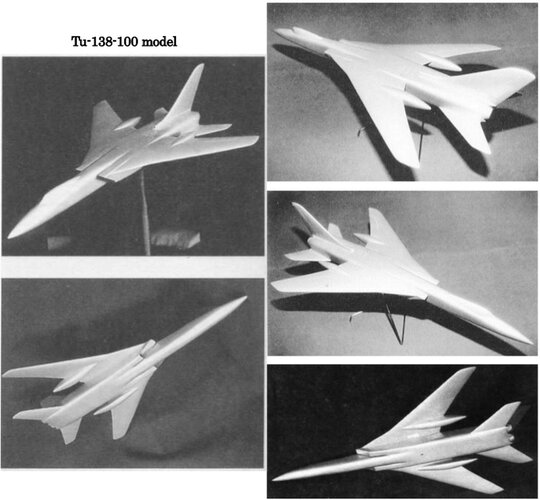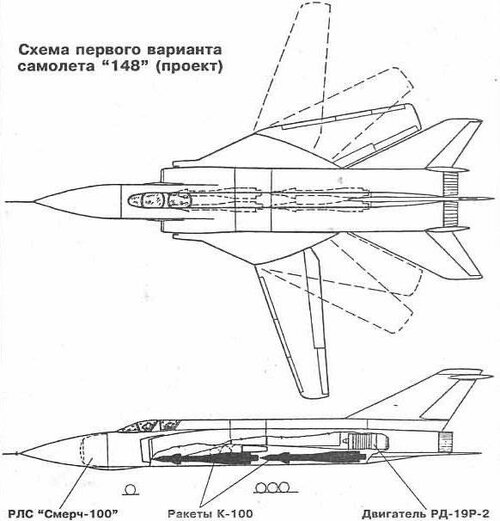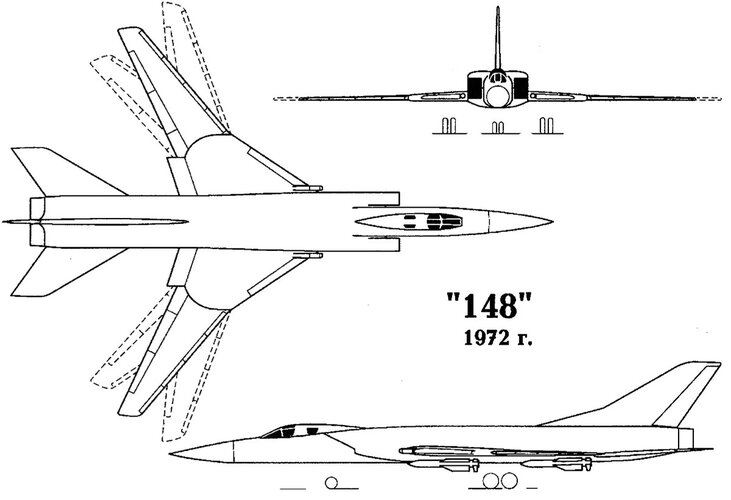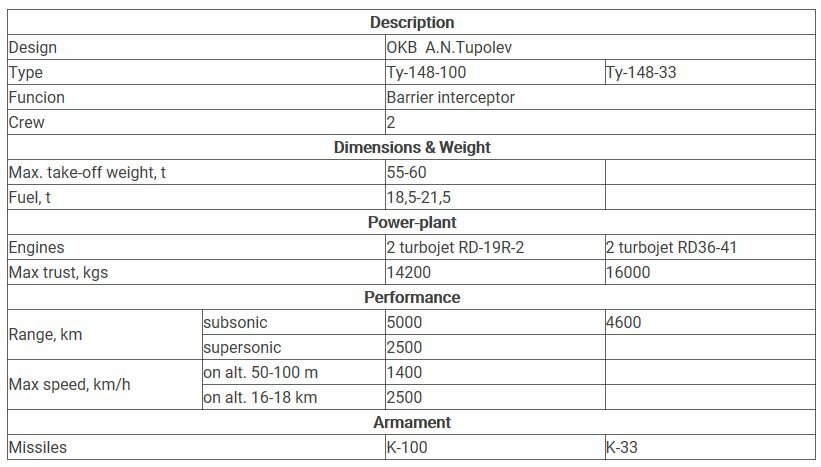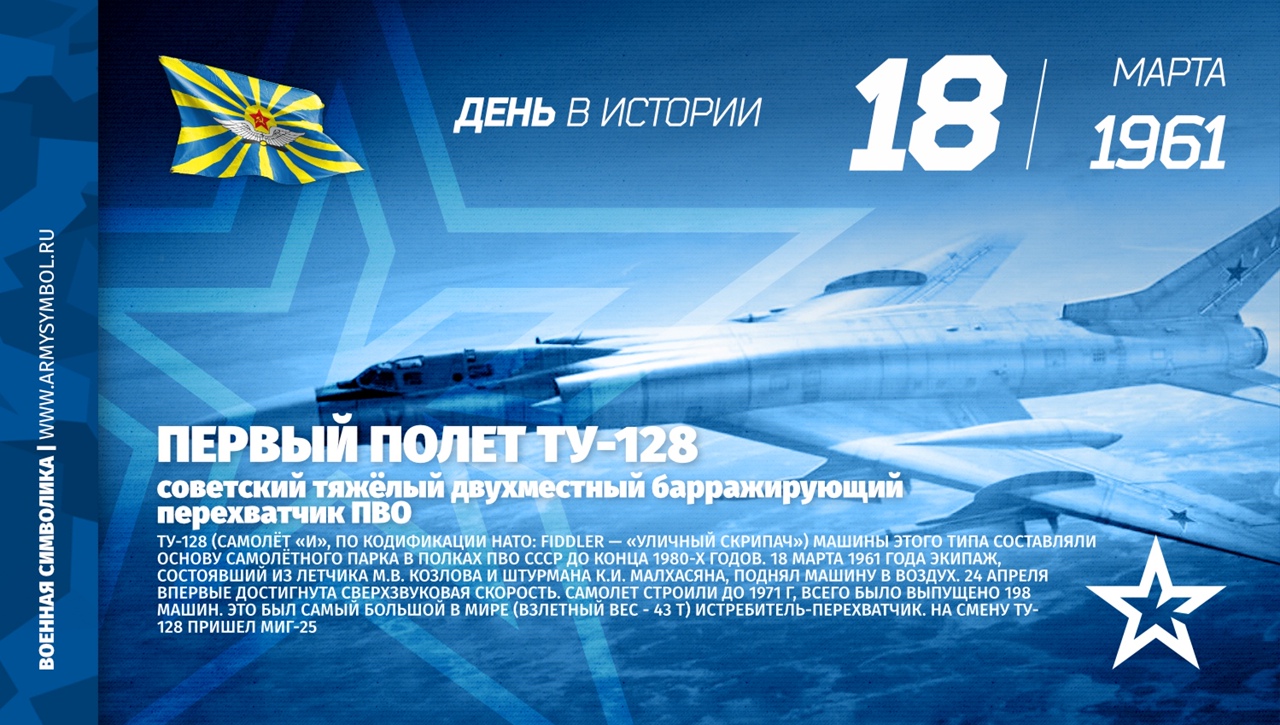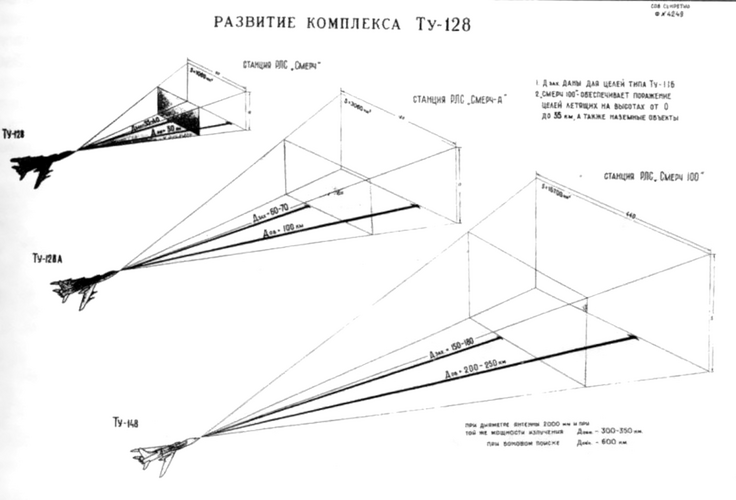Vladimir Rigmant - Assistant to the President, the press secretary, director of the museum of JSC "Tupolev"
DRAFT long-range supersonic fighter-interceptor Tu-138
In the second half of the 60s. in the bureau, headed by Andrei Tupolev, continued design work on the new long-range interception for air defense of the country. As of 1963-1964. were prepared by two similar project complexes distant interception, designated Tu-Tu-138-60 and 138-100, which had basically the same design aircraft carrier "138" (Tu-138) and differed types of board radar missiles.
The aircraft "138" retained the overall layout of the Tu-128, but differs from it a new power plant with WD-19 engines, improved aerodynamics due to the new aerodynamically clean wing with a smaller relative thickness and form a new plan. Unlike the Tu-128, the main landing gear wheels on a plane "138" retracted into the wing root and partially in the fuselage. For complex Tu-138-60 was supposed to use the radar of the "Smerch-A" and missiles K-60, for complex Tu-138-100 - radar "Thunderstorm" and missiles K-100. Providing for the use of missiles K-80 (P-4) complex Tu-28-80 (Tu-128C-4). Modernization of the aircraft carrier, radar and missiles had significantly enhance the ability of the complex to intercept high-speed targets. For example, the maximum speed with missiles increased to 800 km / h, increases the time loitering, improved takeoff and landing performance, increased range of detection and capture objectives radar and range missiles.
During the design of the aircraft "138" models were conducted aerodynamic studies that have shown that the necessary aerodynamic efficiency at cruising subsonic flight can not be obtained due to a significant increase in the midsection of the fuselage (WD-19 and a new radar station had a larger diameter), and hence jeopardized the achievement of the required range and duration of the flight, which was one of the most important requirements for the interceptor. Non-shiny new thin wing obtained takeoff and landing characteristics.
In order to solve the problems have been proposed various options for completion of the project. Wanted to introduce a system of in-flight refueling "cone" of blowing boundary layer flaps and leading edge flaps or achieve greater aerodynamic efficiency of the wing due to boundary layer suction.
However, all these measures or weighting structure, or significantly reduced the efficiency of the power plant due to the selection of air blowing system. By the mid-60s. in KB it was decided to conduct further work on ways to modernize the distant interception on the basis of aircraft with variable sweep wing, which was proposed in the draft "148". Since the beginning of work on this property, all work on the project "138" were discontinued.
In addition to several projects of the aircraft "138", made by the schemes basically follow the original Tu-128, the OKB was offered several options for projects, "138", were based on non-traditional schemes, in particular, have been proposed scheme tailless delta wing and a "duck ". In addition to the engines of WD-19, for the aircraft "138" considered the possibility of using the RD-36-41.
Project of further interceptors TU-148
Work on deep modernization of air-missile system to intercept long-range based on the Tu-128 and gridlock with the design of the aircraft carrier for the new complex Tu-138 OKB insistently demanded that the search for new creative ways in the development of long-range heavy fighter-interceptors. Almost simultaneously with the beginning of the design of long-range missile with variable sweep wing aircraft 145 "in the bureau started designing aviation complex long-range interception, based had to lie heavy fighter-interceptor with variable sweep wing, won the designation of aircraft design bureau" 148 "(Tu 148).
Its design began in 1965. In the fall of 1965 were the main characteristics of the complex and its possibilities of modification to reflect the new configuration of the aircraft carrier. The use of a variable sweep wing in flight, combined with two turbojet engines VD-19R2 can eliminate many of the contradictions of previous single-mode projects and greatly enhance the tactical use of the aircraft. In configurations maximum and expected to get a big sweep speed when flying at altitudes of 50-100 m - 1400 km / h and at altitudes of 16000-18000 m - 2500 km / h and a practical range at this speed - 2500 km.
For flights at altitudes of 50-500 m at speeds of 1400 km / h - 570 km at a speed of 1000 km / h - 1,850 km. With a sweep of the wing corresponding to subsonic cruise provides a range of 4800 km. In the case of in-flight refueling performance in range, depending on the mode of flight, increased by 30-40%. Takeoff and landing performance, even with an increase in take-off weight of the Tu-148 to 55-60 tons (for the Tu-128 - 43 tons) were obtained significantly better than the Tu-128: 800 m length of the runway and the ability to use a third-class airfields and unpaved runways (for the Tu-128 - 1350m and the second class, respectively). In addition to the functions of long-fighter-interceptor Tu-148 after further conversion could be applied for violations of air transport in the operative behind enemy lines - samolet- "raider" to ensure the defense of surface ships at great distances from their bases as a carrier missiles "air-to-ground "for various purposes, including passive homing to destroy ground radar and AWACS aircraft, as a scout radio equipment, low-level and high-rise fotorazvedchika, tactical bombers carrying nuclear and conventional bombs and attack aircraft armed Nursi and guns, to strike by ground forces with a relatively weak defense and small ships. In fact, it was about creating a multi-purpose aircraft.
The second "highlight" of the project, along with a variable sweep wing, identify the person of the project and in many ways it was a proposal layout solutions used on the Tu-148 combined teploradiolokatsionnuyu weapon control systems "Smerch-100" includes radar quasi-continuous radiation with a mirror diameter of the antenna 2.0 m (antenna phased array), thermal equipment channel detection and tracking of targets that transmitted radar, digital onboard computer and radar antenna side-view. The developers of the "Smerch-100" intended to provide a detection range of aerial targets Tu-16 when attacking from the front hemisphere to 300-3500 km detection range in side the search of 600 km detection range teplopelengator on free courses to 100 km. System "Smerch-100" was to provide start-up and management of missiles in the search mode with a range of 250 km when attacking from the front hemisphere. By the time these characteristics looked on the verge of fiction and could in the case of the successful achievement of for many years to solve the problem of long-range aircraft interception. In the first phase planned to equip the complex with K-100 combined with teploradiolokatsionnoy GOS with different types of warheads with a range of up to 80 km, in the future, because the possibility of "Smerch-100" is enabled, it was supposed to go to rockets "air-to-air" more range. Weapons system made it possible to intercept and destroy targets flying at altitudes from 50 m to 32000-35000 m at speeds from 500 to 4000-4500 km / h. The onboard equipment includes the most advanced features of the system: the system trajectory control, the PNA complex, providing autonomous navigation, single-board automatic system for receiving information about the different types of goals, commands from the control, guidance and transfer information to other aircraft system low-altitude flight. All weapons and equipment targeted at different variants of tactical use housed in fuselage gruzootseke. Multiple use of the Tu-148 implied a rapid transition from one model to another in the field. Gruzootseke with interchangeable module calculates the following download options: four missiles K-100; one X-22 or X-28 two or four K-100P; machinery electronic intelligence "Bulat" or "Sabre" or "Bend"; aerial camera (AFA) type "Diamond", panoramic AFA and AFA-42/20 plus an additional fuel tank or AFA-42/20, two AFA-54 and AFA-45; two tactical nuclear bombs or containers with Nursi, or containers with guns with ammunition. In an embodiment of long-loitering interceptor complex Tu-148-100 could provide subsonic line interception 2150 km at a speed of 2500 km / h - up to 1000 km and combined cycle - up to 1700 km. Turn on time loitering 1300 km - 2 hours, and at 500 km - 4 hours. This made it possible to reliably cover the relatively small forces and means of the northern and eastern borders of the country. In case of success of the project defense could get a highly efficient system.
The project had a high degree of saturation of the super modern equipment. And this is how it turned out, was his weakest point, given the level of development of the electronic industry in the USSR in the 60s. Such a complex could actually occur under the most favorable conditions, at least ten years. Which has been confirmed in practice. Much simpler and less efficient system based on the system "Barrier" was released only in 70-ies. Aimed at creating a multi-purpose machine capable of performing the functions and the interceptor, and the front shock machine was not in line with the mainstream of domestic Air Force, which, unlike the US, always wanted to be armed with several types of aircraft narrowly targeted destination, rather than a multi-purpose combat vehicle . As a result of all these factors, the project Tu-148 in this configuration does not arouse the interest of the Air Force and has not been developed.
Work on the Tu-148 came to life in the second half of the 60s., When work began on a new weapon system "Barrier" with missiles K-33 (detection range 110-115 km, launch range 80-90 km), the structure of the building and functionally similar to the "Smerch-100", but which had a much more modest but real possibilities. It was decided to abandon the idea of creating a multi-role aircraft for the Air Force and is fully focused on further interception equipped with modern equipment, which could give our industry. Work on the Tu-148 is now regarded as the further modernization of the Tu-128. Expansion of combat capabilities and effectiveness of the complex as compared to the Tu-128C-4 was achieved by improving the flight and performance characteristics that reduce the minimum flight altitude intercepted goals with 8 km to 0.05 km, providing intercept low-altitude targets against the background of the earth, intercept small targets (air-launched missiles "Hound Dog», SRAM, SCAD and SCAM), expanding the range of speeds, intercepted goals in the forward hemisphere from 2000 km / h up to 3500 km / h and in the back - from 1250 km / h to 2300- 2,400 km / h, increasing the height of intercepted targets with 21000 m to 26000-28000 m, increase noise immunity of the complex, providing a simultaneous attack of two goals, providing group activities that increase the efficiency of the semi-autonomous and autonomous action, increased range and endurance, improved takeoff and landing characteristics , improved acceleration characteristics, the introduction of additional elements of the automation of the main phases of flight. Improving the performance of the aircraft carrier was to be carried out by replacing the engine AL-7F-2 to more powerful RD-36-41, fuselage modifications, alterations, air inlets and canals, installation of a new wing with variable sweep in flight with slats and double-slotted inboard flaps, gain chassis design and implementation of a new type of wheel, the introduction of electron-intertseptornogo stability control and automatic way, the introduction of trajectory control, etc. It was assumed that in a modified form of the aircraft can be operated with the same airports as the Tu-128. Project Design Bureau presented Command air defense of the country. The new complex was supported air defense commander AL KP.
In OKB the works on designing aircraft and complex. Prepared a full-scale model of the Tu-148, which is several times examined by the customer. In May 1968 in a plane crash on one of the first E-155P dies Kadomtsev. The new management of air defense relies on the modernization of the system under the "Barrier" serial MiG-25P, begin work on the E-155MP with "Barrier", a prototype of future serial MiG-31. Formally, a new air defense command of the Tu-148 project for some time refused. Still, it was a question of contacts with the largest and most prestigious in the country by air and with its chief designer AN Tupolev, opinion and expression is a lot of cost. Come a little differently: the aircraft carrier exhibited additional requirements, which largely were at odds with the basic concept of the aircraft and the complex (one of those requirements was the point to significantly improve maneuverability characteristics of the Tu-148 at low altitudes). Kolmogorov himself and his closest colleagues persistently tried to achieve a breakthrough related to the Tu-148 and a formal ruling on the complex, the allocation of money for the further design. But it was all in vain. In the early 70-ies. Work on the complex had finally collapsed. In the future, EDB is no longer engaged in specialized subjects heavy aircraft carrier for long-distance air defense complexes interception. All work in the bureau in this direction in the future were limited to consideration of technical proposals for the creation of long-range heavy fighter interceptor class "raider" based on the Tu-144 and Tu-22M (projects complexes distant interception DP-1 and DP-2), but this work not out of the initial discussion stage projects.

